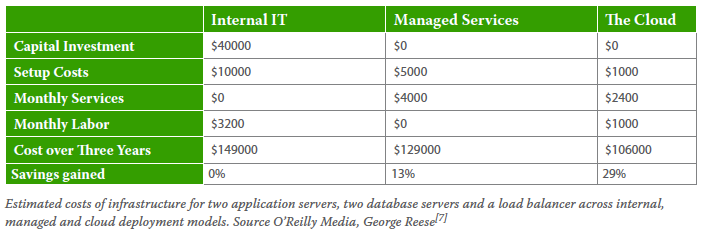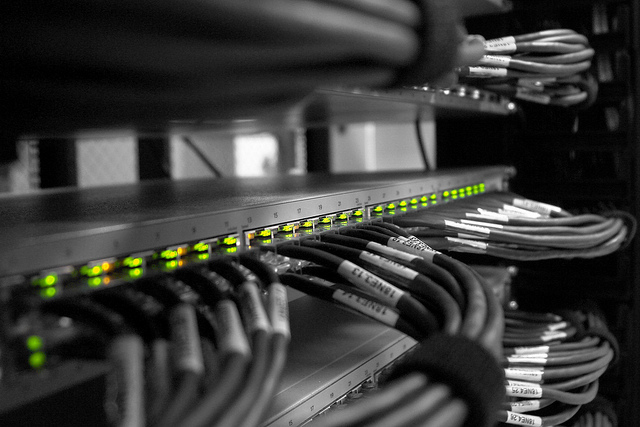Cloud computing economics

/ photo ChrisDag CC
Organizations are moving from traditional IT infrastructure to cloud for a number of reasons. Cloud technologies provide a lot of economic advantages, and today we decided to talk about it.
')
In the IT field there are many situations that are very similar to the 80/20 principle or Pareto law. It is often cited as an example to show how insignificant values would seem to be of great importance. As was shown in the report CloudU, according to Gartner estimates , the cost of operating equipment is about 80% of the cost of IT infrastructure as a whole.
If you look at how organizations manage the infrastructure of their data centers, and summarize the results of Gartner's research, you can see that only 20% of the time and effort spent on building applications — which most of the cost of business depends on — is spent on developing applications. Routine and minor tasks, such as debugging the operating system or creating backups, take significant time from the IT department.
Cloud computing is a tool that completely reverses the principle described above and gives IT departments the ability to devote 80% of their time to key business processes, in particular, to developing business applications. The inefficiency of the existing model is most clearly manifested in the form of opportunity costs incurred by organizations in the process of solving their computational problems.
Historically, most of the costs for IT infrastructure were capital expenditures. The pre-purchase of equipment and the purchase of software licenses were usual expenses, and the decision-making process was very slow. One of the principles underlying cloud computing is a regularly recurring cost model that resembles telephone and electricity charges, in the sense that they are considered normal transaction costs. Instead of capital expenditures, organizations prefer to incur transaction costs for several reasons.
Operational costs are more beneficial to the organization because it has the ability to reduce them on their own and without reference to the acquired servers and software. Regardless of how often they are used in the work, the organization is forced to bear the operational costs arising in the form of depreciation charges. When priority is given to operating costs, then if an organization does not need hardware or software, its costs can dramatically decrease.
The total cost of owning your own infrastructure is much higher. This is shown in the example in the table below.

Estimates of infrastructure costs for two application servers, two database servers, and a load balancer for the classic infrastructure, remote management, and cloud computing models
Purchase of expensive equipment is not an easy task for an enterprise of any scale. It is particularly acute for small companies that have restrictions on their own capital. For this reason, initially, organizations had difficulty in justifying their capital costs in order for their project to be approved.
The transition to a transaction cost model removes this limitation and allows smaller projects to assume more obligations. Undoubtedly, the departure from capital costs attracts many organizations, and the economic benefits of cloud computing are best manifested through an indicator such as TCO.
Virtual infrastructure services offer transparent working conditions and costs can be calculated in advance. This is possible due to several factors:
- Providers have transparent pricing based on metrics for various cloud use options; among them, for example, RAM, data storage capacity, and so on;
- Costs often remain fixed for a certain period of time. This gives customers the ability to easily calculate the value of costs, evaluating various uses;
- Compare this with the local infrastructure. In an article on CIO.com, Bernard Golden (Bernard Golden) talks about why it is difficult to compare the costs of cloud and local infrastructure. In his opinion, organizations often do not take into account internal costs.
Internal costs:
- Direct costs: electricity, space, data storage and management of these resources;
- Indirect costs: network infrastructure, storage infrastructure and management of the general infrastructure;
- Overhead in the operation of servers.
All these hidden costs complicate the process of comparing direct costs. A few years ago, Stanford University professor Jonathan Koomey published an article titled “A Simple Model for Determining the True Value of the Total Cost of Owning Data Centers.” In this article, Kumi presented a table that helps calculate the true TCO value for data centers. This value can be used to compare costs.

/ photo by Andrew Hart CC
With a forced idle cloud services become free. Therefore, the client saves his money when switching from a local infrastructure to a cloud one, if his load changes dramatically. The possibility of flexible scaling depending on the growth or decline in demand allows you to optimize income and expenses.
A virtual infrastructure provider can evenly distribute the load among its customers and make more efficient use of available capacity. Large providers can save on scalability, which is vital in the case of malicious attacks and in other critical situations.
Cloud providers, in contrast to fixed infrastructure, can increase the number of available nodes and, accordingly, reduce the waiting time for the end user. And the overall reliability of the system increases with the additional use of geographically distributed data centers.
These principles were compiled in 2008 by Joe Weinman, who provided their detailed proof. We believe that the most important advantage of cloud services is that they allow organizations to devote more time to key business objectives. This advantage is even more valuable than any cost reduction.
PS Other materials on how we improve the work of the virtual infrastructure provider 1cloud :
Source: https://habr.com/ru/post/302174/
All Articles